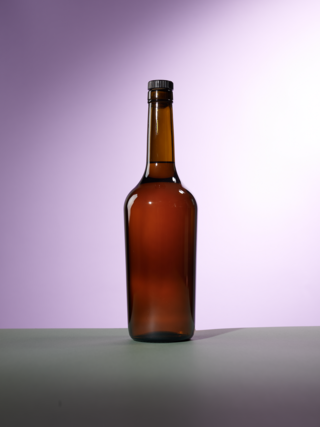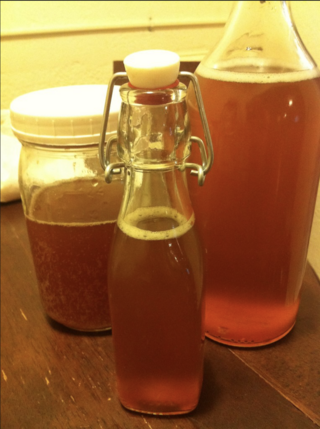



A fruit press is a device used to separate fruit solids—stems, skins, seeds, pulp, leaves, and detritus—from fruit juice.




A fruit press is a device used to separate fruit solids—stems, skins, seeds, pulp, leaves, and detritus—from fruit juice.
In the United States, Madeline Turner invented the Turner's Fruit-Press, in 1916. [1] [2]
A cider press is used to crush apples or pears. In North America, the unfiltered juice is referred to as cider, becoming known as apple juice once filtered; in Britain it is referred to as juice regardless of whether it is filtered or not (the term cider is reserved for the fermented (alcoholic) juice). Other products include cider vinegar, (hard) cider, apple wine, apple brandy, and apple jack.
The traditional cider press is a ram press. Apples are ground up and placed in a cylinder, and a piston exerts pressure. The cylinder and/or piston in a traditional cider press is designed to allow the juice to escape while retaining the solid matter. This is achieved through a controlled gap or a semi-permeable surface, where the pressure exerted by the piston forces the juice out of the crushed apples or pears, leaving the solids behind. The traditional cider press has not changed much since the early modern period. The only difference being that in earlier versions of the press horses were used to power the machine. Diderot's Encyclopedie offers a portrayal of the traditional cider press,
"This is how the cider mill is made. Imagine a circular trough made of wood connected to two wooden millstones like those used in a windmill, but fixed differently. In a windmill, they are horizontal, but in the cider mill they are placed in the trough vertically. They are fixed to a vertical piece of wood that turns on itself and which is placed in the centre of the circular part of the trough; a long axle passes through them; the axle is joined to the vertical axis; its other end juts out from the trough; a horse → is harnessed to it; the ← horse → pulls the axle by walking round the trough, which also moves the pressing stones in the trough where the apples are pounded. When they are judged to be sufficiently crushed, that is to say, enough for all the juice to be extracted from them, the apples are removed with a wooden spade and put into a large vat nearby. Enough apples are pounded to make a pulp or pomace." [3]
Cider presses often have attachments to grind the apples prior to pressing. Such combination devices are commonly referred to as cider mills.
In communities with many small orchards, it is common for one or more persons to have a large cider mill for community use. These community mills allow orchard owners to avoid the capital, space, and maintenance requirements for having their own mill. These larger mills are typically powered by electrical or gasoline engines. Mill operators also deal with the solids, which attract wasps or hornets. Cider mills typically give patrons a choice between paying by the gallon/litre or splitting the cider with the mill operator.
Larger orchardists may prefer to have their own presses because it saves on fees, or because it reduces cartage. Orchardists of any size may believe their own sanitation practices to be superior to that of community mills, as some patrons of community mills may make cider from low quality fruit (windfall apples, or apples with worms). Those making speciality ciders, such as pear cider, may want to have their own press.
The world's largest cider press is located in Berne, Indiana, US.[ citation needed ]
A wine press is a device used to press grapes during wine making.
An oil press is a device used to extract oil from plants and fruits.
Given the simplicity of the design, and high usability, some people (e.g. those owning an orchard) have started building their own do-it-yourself (DIY) fruit press and have uploaded detailed instructions on how to do so.

Calvados is a brandy from Normandy in France, made from apples and/or pears.
Perry or pear cider is an alcoholic beverage made from fermented pears, traditionally in England, particularly Gloucestershire, Herefordshire, and Worcestershire, parts of South Wales and France, especially Normandy and Anjou, Canada, Australia and New Zealand.

A juicer, also known as a juice extractor, is a tool used to extract juice from fruits, herbs, leafy greens and other types of vegetables in a process called juicing. It crushes, grinds, and/or squeezes the juice out of the pulp. A juicer clarifies the juice through a screening mesh to remove the pulp unlike a blender where the output contains both the liquids and solids of the processed fruit(s) or vegetable(s).

Winemaking, wine-making, or vinification is the production of wine, starting with the selection of the fruit, its fermentation into alcohol, and the bottling of the finished liquid. The history of wine-making stretches over millennia. There is evidence that suggests that the earliest wine production took place in Georgia and Iran around 6000 to 5000 B.C. The science of wine and winemaking is known as oenology. A winemaker may also be called a vintner. The growing of grapes is viticulture and there are many varieties of grapes.

Fruit wines are fermented alcoholic beverages made from a variety of base ingredients ; they may also have additional flavors taken from fruits, flowers, and herbs. This definition is sometimes broadened to include any alcoholic fermented beverage except beer. For historical reasons, mead, cider, and perry are also excluded from the definition of fruit wine.

Apple cider is the name used in the United States and Canada for an unfiltered, unsweetened, non-alcoholic beverage made from apples. Though typically referred to simply as "cider" in North America, it is not to be confused with the alcoholic beverage known as cider in other places, which is called "hard cider" in the US. Outside of the United States and Canada, it is commonly referred to as cloudy apple juice to distinguish it from clearer, filtered apple juice and hard cider.

H P Bulmer Limited, trading as Bulmers, is a cider-making company founded in 1887 in Hereford, England.
Bulmers cider is one of a number of brands owned by British cider maker H. P. Bulmer of Hereford, a Heineken subsidiary. It is one of the biggest selling British bottled cider brands in the UK with a number of variants including Bulmers Original & Pear. It should not be confused with Bulmers Irish Cider, sold outside the Republic of Ireland as Magners.
Pomace, or marc, is the solid remains of grapes, olives, or other fruit after pressing for juice or oil. It contains the skins, pulp, seeds, and stems of the fruit.

Cider apples are a group of apple cultivars grown for their use in the production of cider. Cider apples are distinguished from "cookers" and "eaters", or dessert apples, by their bitterness or dryness of flavour, qualities which make the fruit unpalatable but can be useful in cidermaking. Some apples are considered to occupy more than one category.
Fruit brandy is a distilled beverage produced from mash, juice, wine or residues of edible fruits. The term covers a broad class of spirits produced across the world, and typically excludes beverages made from grapes, which are referred to as plain brandy or pomace brandy. Apples, pears, apricots, plums and cherries are the most commonly used fruits.

Cider is an alcoholic beverage made from the fermented juice of apples. Cider is widely available in the United Kingdom and Ireland. The UK has the world's highest per capita consumption, as well as the largest cider-producing companies. Ciders from the South West of England are generally higher in alcoholic content. Cider is also popular in many Commonwealth countries, such as India, South Africa, Canada, Australia, New Zealand, and New England. As well as the UK and its former colonies, cider is popular in Portugal, France, Friuli, and northern Spain. Germany also has its own types of cider with Rhineland-Palatinate and Hesse producing a particularly tart version known as Apfelwein. In the U.S. and Canada, varieties of alcoholic cider are often called hard cider to distinguish it from non-alcoholic apple cider or "sweet cider", also made from apples. In Canada, cider cannot contain less than 2.5% or over 13% absolute alcohol by volume.

A cider mill, also known as a cidery, is the location and equipment used to crush apples into apple juice for use in making apple cider, hard cider, applejack, apple wine, pectin and other products derived from apples. More specifically, it refers to a device used to crush or grind apples as part of the overall juice production.

The Foxwhelp is a very old cider apple cultivar, originating in the west Midlands of England.

An oil mill is a grinding mill designed to crush or bruise oil-bearing seeds, such as linseed or peanuts, or other oil-rich vegetable material, such as olives or the fruit of the oil palm, which can then be pressed to extract vegetable oils, which may be used as foods or for cooking, as oleochemical feedstocks, as lubricants, or as biofuels. The pomace or press cake – the remaining solid material from which the oil has been extracted – may also be used as a food or fertilizer.
Cider in the United Kingdom is widely available at pubs, off licences, and shops. It has been made in regions of the country where cider apples were grown since Roman times; in those regions it is intertwined with local culture, particularly in the West Country.

In the United States, the definition of cider is broader than in Europe. There are two types: one is the traditional fermented product, called hard cider, and the second is sweet or soft cider. However, in some regions, cider is the alcoholic version, whether made from apples or pears, and apple cider is the non-alcoholic version.

The Woodcock was one of the oldest described English varieties of cider apple. It originated in the West of England in the counties of Herefordshire and Gloucestershire.

Cider syrup is also known as apple molasses. It is a fruit syrup concentrated from apple cider, first made in colonial America. It is a thick, dark brown, opaque syrup with concentrated apple flavor. The color is darker than honey and its flavor more tart than maple syrup. A syrup-like product has a much longer shelf-life than the fresh fruit, thereby extending the apple harvest's contribution to diets throughout the year.

The cuisine of Monmouthshire is historically associated with Lady Augusta Hall, also known as Lady Llanover, who published one of the first Welsh cookery books called First Principles of Good Cookery (1867). The book uses a fictional Welsh hermit to give culinary advice to a visiting guest who is travelling though Wales.
![]() This article incorporates text from a publication now in the public domain : Easton, Matthew George (1897). Easton's Bible Dictionary (New and revised ed.). T. Nelson and Sons.
This article incorporates text from a publication now in the public domain : Easton, Matthew George (1897). Easton's Bible Dictionary (New and revised ed.). T. Nelson and Sons.{{cite encyclopedia}}: Missing or empty |title= (help)